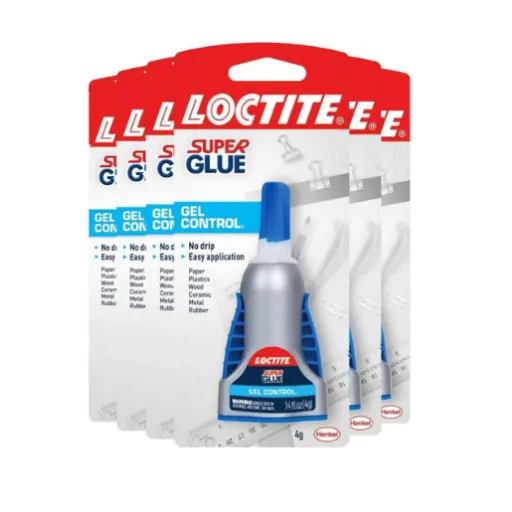When fast fixes and stronger bonds are concerned, adhesives such as Loctite or Super Glue are household names that tend to get passed around. And so with these two similarly strong options at hand, how does one decide which is right for his or her task? From fixing broken items to carrying out home improvement tasks and going all the way in a creative DIY experiment, the adhesive used can sometimes stand to mark all the difference. This article will put side by-side Loctite and Super Glue, looking at their relative strengths, applications, and performance. This way, you’ll learn which glue works best for you. Time to strengthen those repairs or projects!
Understanding Adhesives
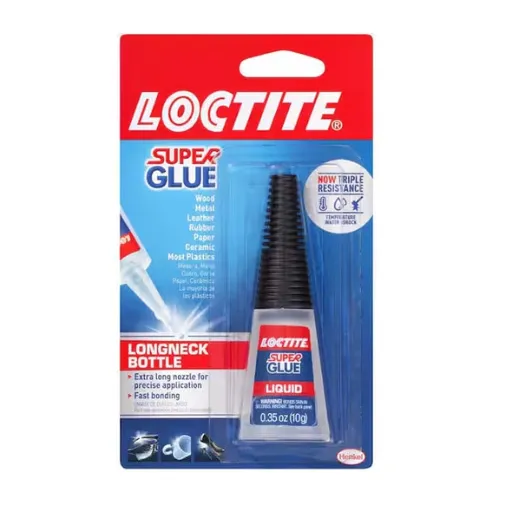
What is Super Glue?
Super glue is widely acknowledged as an adhesive with fast bonding abilities on a wide variety of materials. There are several types of cyanoacrylate-based adhesives that cure almost instantly when exposed to moisture, including the humidity in the surrounding air. This versatility renders it usable for household repairs, various crafts, and many other applications.
Among the features that make it so famous is the strength of the bond. This glue is good for bonding materials like plastics, metals, ceramics, woods, and rubber; for example, gluing a broken item or piecing together components in a small project. In addition, once it cures, super glue forms a strong bond that can resist heat and normal water conditions, which affords it reliability for a long time.
There are a few limitations of super glue fa, especially because of its quick-setting nature and resulting rigidity. It is less desirable on flexible surfaces as well as when a filler is needed. Also, care should be taken when handling super glue; in most cases, it can bond to accidental skin and other surfaces almost immediately. This, however, does not reduce the value of this glue for daily and special applications, which due to its convenience, are used with regularity by almost everyone.
What is Loctite?
Loctite is the type of adhesive known for its unbeatable bonding strength and versatility. Being able to bond metals, plastics, woods, or ceramics, Loctite finds applications in industrial and professional areas as well as for repair work at home. It is especially valued for its dependable nature, withstanding various environmental stresses such as heat, vibrations, and moisture.
The principal difference in Loctite adhesives is their ability to cure or set or harden quickly while offering great strength. Some Loctite products can be used for permanent solutions while others offer temporary solutions, depending on their method of application. For instance, thread-lockers keep bolts and screws secure and also prevent loosening through vibration, whereas removable adhesives should be removed when possible.
Loctite’s preferred choice in across different industries for ease of use and durability long enough to serve their needs, such as in the automotive industry, construction, and electronics. Also, the diversity of specialized formulations assures the availability of an adhesive designed for every application f,rom computer precision to fast household fixing.
Key Differences Between Super Glue and Loctite
Both are strong adhesives that have found their place in use over time, yet many differences between them make them suitable for different types of applications. Thus let us compare these two:
📊 Composition and Strength
Super Glue is a cyanoacrylate glue that sets almost instantly on bonding with different materials such as plastic, metal, and wood. Generally, most of the glues have a brittle bond, so they may break under heavy stress or vibration. Loctite, however, offers a wider range of adhesives, which incorporate cyanoacrylates, epoxies, and even anaerobic adhesives. Therefore, this option makes formulations that Loctite extends to options that can withstand some degree of stress and are durable to temperature changes and moisture exposure.
🎯 Intended Use
Super Glue is popular for quick fixes and light repairs in household settings, suitable for smaller works when time and convenience matter. The Loctite products are more industrial in nature, but they are home-use adhesives as well. Adhesives of Loctite are formed for all kinds of applications, from fixing bolts in automotive assembly to bonding structural components in construction.
🌡️ Temperature and Environment Resistance
Loctite products are designed for the highest performing environments. Loctite threadlockers can maintain their properties at temperatures of 300°F (149°C) and above, while a typical Super Glue would lose its effect if exposed to temperatures above 180°F (82°C). Moreover, Loctite is more resistant against moisture, oils, and chemicals than Super Glues and hence is the choice for harsher environments.
⏱️ Curing Time
Super Glue dries in seconds or within minutes, so it is ideal for small, quick repairs. Loctite, depending on the formulation, may take a longer time to fully cure but once set, it makes a much stronger and longer-lasting bond. For instance, anaerobic Loctite adhesives harden only in the absence of air and with metal contact, giving the best industrial-strength bond.
🔄 Flexibility and Customization
While general-purpose Super Glue offers a rigid cure, Loctite adhesives present a flexible spectrum of glue solutions. This flexibility, in turn, makes Loctite better suited to dynamic loading, vibration, or thermal expansion.
📦 Range of Products
From a versatility point of view, Loctite clearly holds sway with its line of specialty products across the spectrum of adhesives, including threadlockers, gasket sealants, and adhesives for metal bonding. For example, Loctite’s Threadlocker Blue 242 will provide a removable bond to bolts, whereas Loctite’s Epoxy will create a high-strength bond between dissimilar materials. Just by its simplicity of use, such a variety is not available with Super Glue.
Types of Super Glue and Loctite
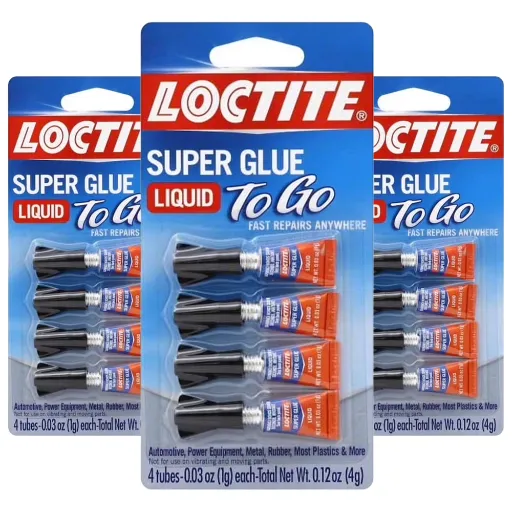
Super Glue Gel vs. Liquid
The first visible difference between super glue gel and liquid lies in the viscosity of the two. Gel is thicker, so it stays put without dripping or running. This makes it appropriate for vertical surfaces and other places where an exact application is required. It also works well on porous surfaces because the thicker consistency allows a greater filling effect of small gaps.
In contrast, liquid super glue is thin and flows with ease. It can be used on smooth, non-porous surfaces where it quickly spreads and hardens into a bond. It is also an acrylic kind of glue u, usually preferred when materials require an extraordinarily tight and seamless fit between them because it goes into barely visible cracks and performs very well in adhesion.
Depending on the project in question, gel or liquid super glue is selected. When precise application and gap-filling bonding are in function, gel glue should be chosen. For bonding non-porous materials where an imperceptible bond is desired, liquid glue excels. One must consider the strengths of each glue type in order to make the appropriate choice for their set of circumstances.
Loctite Super Glue Liquid Professional
Loctite Super Glue Liquid Professional is best described as heavy duty with an exceptional bonding capacity over numerous surfaces. Professionals and DIYers wish to utilize this glue in their projects that require ultimate performance when working with non-porous materials like metal, glass, and plastics. Equipped with a precision applicator tip, it is an easy product to use accurately, resulting in clean application in tight spaces.
This glue dries clear, so an invisible bond is just as aesthetic as it is strong. It is fast-drying, cutting down on project completion time. Its thin viscosity allows it to enter tiny cracks and spaces between surfaces to form a strong adhesive hold where other adhesives may fail, thus providing utility in fine repairs and craftsmanship.
Choosing the right kind of adhesive must be made relative to the requirements of the particular job. Loctite Super Glue Liquid Professional will work well in most situations but preferably on smooth non-porous surfaces. In different situations, however, when bonding uneven or porous materials, it may require a different type of adhesive. Always follow the direction of application for the bond to stay intact for long.
Gorilla Glue as an Alternative
Depending on the surface, Gorilla Glue can be widely used, which is the go-to glue for a very strong bond on wood, metal, ceramic, foam, etc. It has the benefit of expanding while curing and hence filling gaps and uneven surfaces. This makes it a great glue alternative for some porous or irregular materials where another glue may be insufficient.
When handling Gorilla Glue, the utmost care of following its application procedure gives the best results. Firstly, the bonding surface has to be clean and should, mostly, be kept slightly damp. Being an adhesive, it contains moisture which creates a strong hold through reaction. Afterward, due to the glue’s expanded application, clamping the pieces together gives stability while also limiting excess expansion. Depending on the glue used, it can take from an hour to 24 hours for the glue to cure so that the joint can be worth using.
While Gorilla Glue performs very well in much poplar application, there might be a few occasions where the glue is just not good for a certain job. The really heavy-duty kinds of Gorilla Glue that are expandable may put a little bit of wiggle into jobs requiring very tight tolerance in the exact placement of materials being joined or can ruin precision work altogether. It might also require cleanup afterwards due to extra expanding. Assessing your situation’s needs will help clarify whether this glue fits the glue job, or if a glue having better working control may be more suitable.
Applications of Super Glue
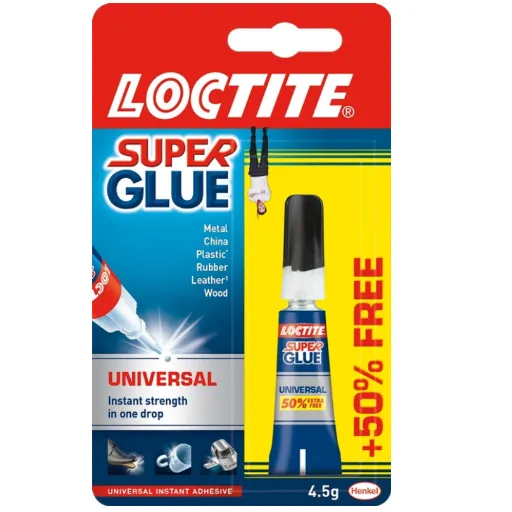
Best Uses For Super Glue
The term super glue refers to a glue with quick set properties and a strong bond that requires maximum durability until set. Typically, it is a fast-acting glue, working well with small, rigid surfaces where precision sets in. One should be able to superglue plastic, metal, ceramic, and rubber if they apply it fast enough before the formula sets almost instantly.
One of the best uses for super glue is for repairing household things that break here and there one excellent use is for all sorts of ceramic fixes, customer plates, or bills of exchange, while The gluing power is very strong and really works to restore the broken functionality while giving a very neat finishing look. Moreover, it is suitable for applications in mending appliances, jewelry, or tools that are barely cracked or broken. Super glue affords very strong adhesion, lasting all along, provided proper surface treatments were afforded beforehand.
Another common super-glue application in crafting and DIY projects is using its quick-drying properties to ensure efficient and seamless assembly. Whether the beads for jewelry-making or delicate pieces in model-building, super glue affords precise application with firm bonding. Additionally, in emergencies, one can use super glue to close up small cuts or wounds, but only when medical glue is not readily available and only as a temporary fix. Have surfaces clean and dry before applying to ensure optimal efficacy and durability.
Plastic Bonding with Super Glue
Super glue generally works well for bonding plastics, yet its success depends on the type of plastic joined. For example, super glue usually works well on hard plastics such as acrylic or polycarbonate, but may have trouble bonding low-energy plastics such as polyethylene or polypropylene, unless the surfaces undergo further preparation or additional types of adhesion are employed.
Preparation of the surfaces of the plastic must be followed by gluing to obtain the strongest bond. It is advisable to clean the surfaces so that no dirt or grease or moisture can interfere with the grip of the glue. Light sanding of the plastic with fine-grit sandpaper may work better for adhesion, as it imparts a very slight roughness to the surface.
Now, super glue forms a bond very fast and relis atively durable under good conditions, but it doesn’t necessarily serve the purpose for every kind of plastic or every use. Should there be plastics that need flexible bonding, are under stress, or require long exposure to moisture or heat, there should be epoxy or special plastic adhesives as other alternatives you can consider. In any case, do check the instructions and compatibility on the label so that your project will yield the best results.
When to Use Super Glue Instead of Loctite
Both superglue (cyanoacrylate adhesive) and Loctite are reliable adhesive solutions but they are suited for certain requirements and occasions. Super glue is used for light objects and for quick fixes, mainly because it has a very quick setting time and is very easy to use. It performs well on small items like ceramic repairs, plastic toys, and wood surface assembly. A major advantage of superglue is that it dries instantly on exposure to moisture in the air, whereas on normal repairs, a quick fix will do.
According to recent data, super glue forms the strongest bonds on nonporous surfaces such as glass, metals, and some plastics under normal conditions: temperature and humidity. It may, however, lose strength upon prolonged exposure to higher temperatures or moisture and so is not suitable for outdoor equipment or projects where heavy stress or load-bearing applications are involved.
However, specialized Loctite adhesives work on threadlockers for industrial-scale repairs or applications where endurance under extreme vibrations, pressure, or constant exposure to heat and moisture is required. For example, Loctite serves well in holding bolts, metal joints, or mechanical assemblies that must maintain structural soundness over time.
Thus, with super glue and Loctite, the choice will depend on what you are repairing or working on. Super glue would be for an easy, quick fix for light objects or surfaces that are not going to bear much stress, while if the job needs an awesome strength and resistant long-term bond under stringent conditions, one would turn to Loctite or something similar. Always double-check the properties and instructions pertaining to an adhesive, and select the one that suits your needs.
Applications of Loctite
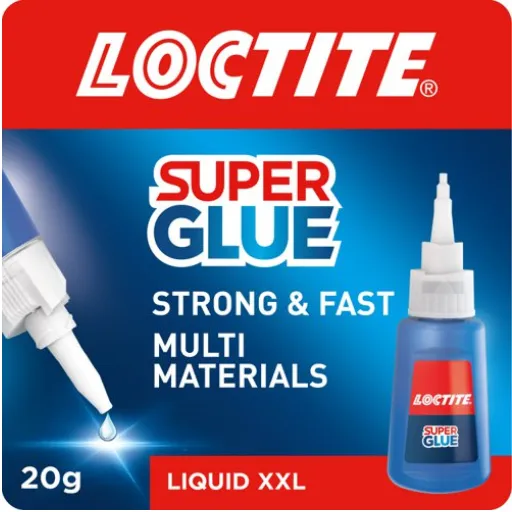
Best Uses for Loctite
Loctite boasts versatility and strength for repair and enhancement all over various industries and even home applications. The various specifications needed for a task require Loctite formulations to perform that task. Some of the applications of Loctite given below based on its range of products:
Automotive Repairs
Loctite is an adhesive that goes into machinery and automobile repairs. It is perfect for retaining bolts, screws, and fasteners with threadlockers that keep these from loosening under vibration. Loctite Threadlocker Blue 242 and Red 271 are the most popular, suitable for medium and high-strength holding applications, respectively.
Plumbing and Sealing
Loctite admits to being water-resistant and leak-proof, making it suitable for plumbing applications. Loctite Plumber and Marine Epoxy will seal pipe leaks and repair ceramics or plastics under damp conditions. It can withstand water and extreme temperatures.
Electronics and Circuit Boards
Loctite provides adhesives for delicate repairs that ensure strong bonds without destroying circuit functions. Its cyanoacrylate adhesives are also used to cement tiny parts in electronic devices with extreme precision.
Heavy-Duty Industrial Use
Loctite industrial adhesives, such as epoxy and structural adhesives, are used to assemble metals, plastics, and composite materials. These adhesives increase the durability of manufacturing projects and are preferred tools in aerospace, automotive, and heavy machinery projects.
Home Repairs and DIY Projects
For typical home repair jobs, Loctite adhesive products are offered, such as Loctite Super Glue, which bonds different materials like wood, metal, ceramic, and many others. Furniture repair, fixing broken items, or making craft items-the name ensures that the Loctite never fails and lasts forever.
Glass Bonding
Loctite Glass Glue is designed especially for weather-resistant, transparent bonds on glass surfaces. It can be used to repair glass objects such as windows, vases, and aquariums.
Thread Locking with Loctite
Several applications require thread locking for the stability and permanence of threaded fasteners in mechanical assemblies. Thread lockers are usually applied on screws, bolts, or other fasteners to prevent loosening due to vibration, temperature changes, or simple wear and tear. By filling in the thread gaps and making a strong bond, thread lockers greatly increase the reliability of bolted connections.
Here are some easy steps of using a thread locker, which, in the longer run, saves time and effort. Prior to application, clean the threads out of any grease, oil, or debris that can interfere with adhesion. Apply the thread locker to the threads of one side, and continue with assembly. Then, once the fastener is tightened, the fastener cures and forms a very strong seal that resists any movement. Most thread locking products, however, have a formulation that allows for disassembly under standard hand tools when needed, allowing easy adjustment or repair.
Thread locking solutions find great application in industries such as automotive, aerospace, and construction, where reliability and safety are top priorities. They are also good for home projects and ensuring that various screws and bolts remain securely in place over time. With such diverse formulations available, these products work for different application intents; for example, from permanent bonding to removable ones while still being able to hold something in place that frequently needs adjustment.
When Should I Use Loctite Instead of Super Glue?
When the application demands strength, long-term durability, or exposure to different environmental situations, Loctite becomes the obvious choice over super glue. Super glues are often considered to come together and dry very fast for materials that are lightweight. On the other hand, Loctite glues withstand much heavier loads and vibrations and harsh conditioning, essentially ideal for industrial or mechanical applications.
Loctite would be better than super glue in any given scenario requiring a more accurate or special kind of bond. Some types of Loctite are meant to thread, seal, or bond metal parts together to ensure that they will stay joined through stress over time. This is in fact an ideal solution for arrays of tasks like assembling part of machinery or securing bolts in position — situations where standard adhesives would fail.
Loctite would be preferable when a bond must retain its reliability in extreme temperatures or chemical exposure. Many Loctite products are manufactured to resist decay under high-heat environments or by exposure to oils and solvents, thus making them suitable for automotive or industrial settings. In the case of super glue, quick-fix solutions are indeed considered, but under demanding circumstances, Loctite prevails as the stronger and dependable alternative.
Performance Characteristics
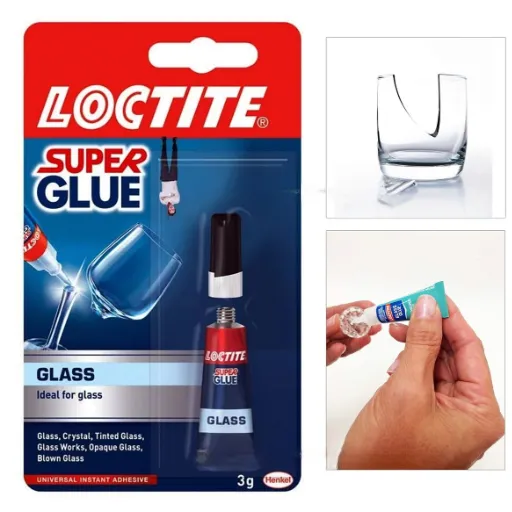
Strength and Durability Comparison
When discussing strength and durability, the considerations weigh heavily on adhesive bond strength, environmental conditions, and the ability to stress over time. Strong adhesives are fundamentally those that could form a bond capable of carrying some significant load and then being tested against a number of situations: vibration or impact or whatever it is. These tests are performed to guarantee good performance under normal as well as adverse service conditions.
In order to determine the durability of an adhesive, one senses how well it maintains its performance over time, in field-hardened conditions. Some adhesives have been formulated to resist degradation under heat, moisture, or chemical exposure. This ends up making them liquids that would be suitable for long-term use, even in demanding environments, without adversely affecting their bonding strength.
Under any other circumstance, it would be the specific requirements of a project that dictate the right adhesive. A light, temporary bond is best achieved with an adhesive that is less durable in nature. On the other hand, adhesives for structural or industrial use must sustain strength and durability while being subjected to extreme conditions. Therefore, knowing the requisites of the application will help choose a product that offers both reliability and performance.
Curing Time and Ease of Use
The curing time and ease of application of an adhesive largely influence its selection and application. Curing time denotes how long it takes an adhesive to fully harden and achieve that maximum initial bond strength. The cure time may vary considerably, depending on the different types of adhesives, the specific materials being bonded, and environmental conditions like temperature and humidity. Faster cure adhesives would be more straightforward for projects where fast assembly is needed, whereas slow cure adhesives offer an option for correction during the bonding process.
Ease of use becomes another factor when customers have less experience or when the application presents complex circumstances for selection. For the ease of application, an adhesive should be simple to apply and require little to no surface preparation, and the application process itself should be forgiving. Adhesives that demand less mixing or are ready-to-use appear to be more time and labor saving for service use, especially in higher volume or industrial settings.
Therein comes a very specific balancing dance these two considerations must make depending on task specificity. For example: if precision is needed,-slow curing adhesives would be the choice for some adjustments to be made. On the other hand-fast curing adhesives would streamline processes if speedy production was the chief concern. Choosing the right adhesives guarantees not only the greatest performance but also ease of application, tailored to the task at hand.
Temperature and Chemical Resistance
Adhesives resist temperature and chemicals along critical parameter of their application consideration. An adhesive in an extreme temperature environment should preserve its bond integrity under heat or freezing conditions. Thermal stability means the preservation of chemical properties so that it does not degrade or lose its bonding strength during temperature fluctuation and is particularly essential when applied in industries such as aerospace, automotive, and construction. An adhesive should be compatible with the temperature range specific to an application in order to render outstanding performance and guarantee longevity.
Chemical resistance also plays a role because many adhesives are subjected to attacks by harsh substances like solvents, acids, or oils. The highest chemical resistance in adhesive bonding involves the sustained interactions that do not cause a destructive attack on either material or the breaking down of reaction intermediates until the ravaging agents may be introduced into the interaction. Especially for frequent contact with agents liable to destroy the functional parts, the use of manufacturing and surgical apparatuses requires such adhesives. This resistance lends endurance and maintains performance even in adverse conditions.
While determining an adhesive’s resistance to temperature and chemicals, various factors should be considered: environment, frequency of exposure, and application of the bond. The testing should take place in conditions as similar as possible to those found in real life so that the adhesive can fulfill its function. At the end of the day, the repertoire of an adhesive can take up some of the importance for thermal and chemical resistance just because that protection encompasses the final product assembly’s durability, safety, and efficacy.
Frequently Asked Questions (FAQ)
❓ What is the difference between Loctite and super glue?
Loctite, as a brand, offers an array of glues, super glues among them. Super glue is a generic name for adhesives composed of cyanoacrylate that binds fast and strong. Loctite brands are made for specific applications to perform much better than ordinary glues with names like superglue.
❓ Can I super-glue plastic?
A super glue can bond plastic, but you must be sure to use one that is specifically made for use with plastics. For instance, Loctite super glue ultra gel is best for bonding hard plastics.
❓ How long does it take for Loctite super glue to cure?
Loctite super glue cures within seconds to minutes, depending on the surface materials and environmental situations. For best results, make sure the surfaces are clean and fit together well.
❓ Is Loctite better than Gorilla Glue?
Choosing Loctite or Gorilla Glue depends on the job at hand. Loctite super glue performs better and faster when it is about quick bonding and bonding with precision. On the other hand, Gorilla glue is the way to go for a big project needing flexibility and strength.
❓ Can I use Loctite super glue on ceramic?
Yes, Loctite super glue is especially formulated to fix ceramic items. The strong bond can enhance repairs to breaks and chips in ceramic materials.
❓ What kind of surfaces can superglue bond?
Super glue bonds well upon a variety of porous and non-porous surfaces, including wood, metal, plastic, and sometimes even leather. When in doubt, the Loctite range of super glues would provide the best result.
❓ What superglue is best for DIY projects?
The best super glue for DIY projects depends on what materials you are working on. In the general sense, Loctite super glue ultra gel is highly rated because of the clog-free nozzle and maximum control in application.
❓ Can I use super glue instead of Loctite for thread locking?
The super glue can give a temporary bond; however, it is not recommended as a thread-locker. Loctite threadlocker is specially formulated to hold threaded fasteners in place and keep them from loosening under vibration, so it will do a far better job in issued applications.
❓ How do I apply Loctite super glue for maximum control?
Loctite super glue ultra gel is the answer for maximum control through application. Utilizing its patented side-squeeze design, applying an accurate dose is made possible without clamping, making it easier to work with delicate materials.
❓ What is ethyl cyanoacrylate, and why is it important in super glue?
What holds the fast bond together in the superglue? The answer is ethyl cyanoacrylate. From fast curing time to immediate adhesion, its unique properties make it useful for engineering needs. It provides a strong hold over both porous and nonporous surfaces.
📚 References
-
Loctite vs Other Brands: Which Glue Holds Best?
This blog compares Loctite with other super glues, discussing drying times, bond integrity, and use cases. -
Super Glue Instead of Loctite – Will I Die? – Bike Forum
A forum discussion on the differences between super glue and Loctite, particularly in temporary and water-exposed applications. -
Loctite Vs Super Glue? – DIY Forums
A detailed thread explaining the curing mechanisms of Loctite and super glue, and their effectiveness on different surfaces.
















